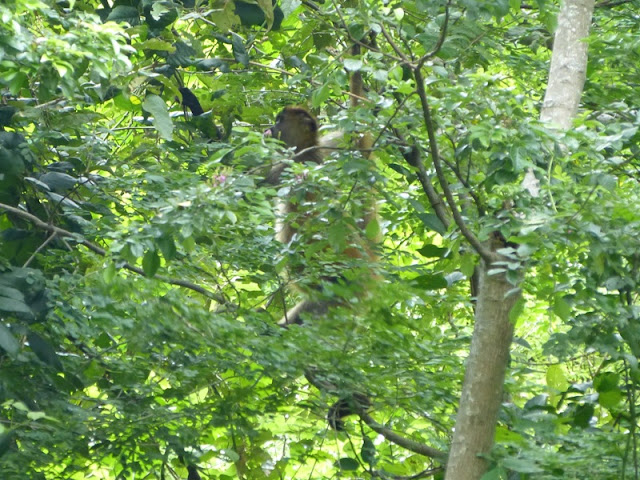This female Barred Yellow was laying eggs and was being pursued by a male. It isn’t a very good picture, but it shows the bars on the upper side of the wings.
Occasionally I would see a Black Patch, Chlosyne melanarge, drift past and if they did land, it was usually high up in a tree. However, one morning this one was much more obliging, choosing to settle on the hot concrete on the track. For some reason my camera struggled to focus on it, but notice the two red dots at the bottom of the hind wings.
I was a little confused by the butterfly below, which turned out to be a Bordered Patch, Chlosyne lacinia. This is a very variable species, with various forms that have different amounts of orange markings on both the forewing and hind wing, but I have never seen a picture of one which has no orange on it at all. I was hoping to see some of the different orange variants. However, I love that despite it 'just' being a black and white butterfly, it has blue eyes and yellow legs!
I was delighted to see this Tailed Orange, Pyrisitia proterpia. This is a wet season form of the species and the dry season form has longer tail-like projection to its hindwing. The males and females also have slightly different colouration and marking. These whizzed along the vegetation at the side of the track.
A more obliging white was the Lyside Sulphur, Kircogonia lyside. There were a few of these medium-sized butterflies feeding on the smaller flowers along the verge.
I spent a long time trying to get a photograph of a Tropical Buckeye, Junonia zonalis. These were very alert butterflies that would fly off when I got anywhere near them. I noticed them in quite a few locations along the track, but their favourite spot was a helipad. Despite me thinking that the sun was quite intense (when it shone!), they obviously enjoyed the reflected sun from the concrete.
There has been a lot of confusion about exactly which species of Tropical Buckeye occurs in Central America and the Caribbean. It was thought that Junonia evarete and Junonia genoveva both occurred in the area. These species are often confused with books and internet mixing up photographs and common names for them. Luckily, it has now been established that these two species occur in Southern America. The species found in central America and the Caribbean is Junonia zonalis, which makes life a lot easier!
This beautiful little butterfly is a metalmark, or Riodinidae, of the genus Calephelis, but I can't be more specific than that! There are said to be about 40 different species in Costa Rica, many of them very similar-looking. I have three books that show Central American Calephelis and all three of them say that more research is required to determine exactly how many species there are and that it is impossible to separate them without genital examination or DNA analysis. I love the three rows of metallic scales on its wings.
There were so many butterflies flying amongst the vegetation at the sides of the track. The majority of them flew past without stopping, or only briefly inspecting flowers on their way. There was one intensely orange butterfly that I followed backwards and forwards for ages, but I didn't manage to photograph it. I can only assume it was a male Tailed Orange.
Another butterfly that evaded me for some time was a larger white butterfly. I managed a couple of very distant shots, which were just good enough for me to identify it as a Florida White, Appias drusilla, from its wing shape. I had better views of this species in the hotel grounds later on our holiday.
The last species I saw along this track was the Glaucous Cracker, Hamadryas glauconome. These are very much lighter in colour than the Guatamalan Cracker I had seen at the hotel. Unfortunately, they didn’t stop for a photograph!
Here is a picture of a butterfly that I can’t identify. When I took it I thought that it was a very small sulphur such as a Eurema. It has some features of a Tailed Orange, but the wings don’t appear to be angular enough and it was certainly smaller than the others I saw. It may remain a mystery!
By the end of our two week holiday I noticed that the number of butterflies I was seeing was increasing. I don't know if that is as a result of the season changing, or the slightly better weather we had. I still had to check out each butterfly I saw, just in case it was a new species. I couldn't believe how many Theona Checkerspots there were. They are such beautiful butterflies, but I found myself thinking to myself, "No, just another Theona Checkerspot"!!
As well as all of the beautiful butterflies I have mentioned in my last few posts I saw a number of Skippers, or Hesperiidae. I will try and put pictures of all of them in my next post.







.jpg)














